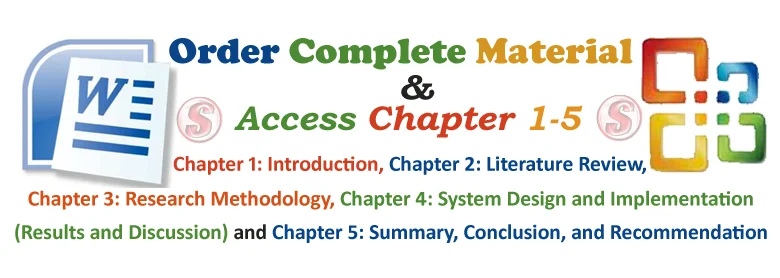1.1 Introduction
Computerized recycling system is an application system that provides information about recyclable materials, which are separated from the waste stream collected and managed on green environment (site). E-waste is a collective name to all electronic devices which have been expired of their useful life period like discarded computers, computer peripherals, mobile phones, televisions, and others. E-waste has increased the total waste volume and after dismantling, it releases various toxic and carcinogenic gases and metals which are posing a threat to human health and also contaminate the environment. It is not only the locally generated waste but also added by the e- waste coming from other parts of the country and overseas in order to be dumped after recycling. The huge import of e-waste which is coming as charity to the developing countries like India, the question is where to dump this burden and how to manage this waste which has become a serious environmental threat nowadays.
As a prelude to other parts of this study, this chapter will discuss the background upon which this study was initiated, the statement of problems that led to this study, the Aim and Objectives of the study. Others are Significance of the study, Scope of work, Limitations of the Study and Definition of technical terms.
1.2 Background of Study
The idea of recycling began during the First and Second World Wars, when countries suffered from a severe shortage of some basic materials such as rubber, which led to the collection of these waste materials for reuse. After years, recycling became one of the most important methods for waste management; For many years, direct recycling by scrap producers was the basic form of recycling, but by the early 990s, the focus was on indirect recycling, ie, the manufacture of waste materials to produce other products based on the same raw material as recycling of glass, paper, plastics, aluminum and other materials. Industry experts have found that if recycling programs are taken seriously, they can help reduce the cost of raw materials and operating costs, and improve their image as being guilty for environmental pollution.
According to Roch man, Browne (2013), in the year 2012 alone, it was estimated that about 280 million tons of plastic has been produced worldwide. From that amount, about 130 million tons of the plastics were land filled or recycled. Of the remaining 150 million tons, plastic will find their place in daily lives of human being. Meanwhile, the rest of the plastic fraction find their final way as litters in the oceans or land filled. Consequently, the plastic waste brings serious environmental threat to modern society because it is made up from several toxic chemicals, and therefore plastic pollutes soil, air and water if not properly managed or treated (Saikia et al., 2012; Kamaruddin et al., 2017).
Accordingly, when most of the available plastic today is made up from non-biodegradable sources, land-filling by using plastic would mean burying the harmful material for over a period until it naturally degrades. In their original condition, any plastic materials would increase the waste volume during land filling. However, their degradation rate and bulky in nature creates environmental risks tremendously. Besides, the plastic waste mass may hinder the ground water movement (Silva et al., 2014). Plastic waste may usually in the form of film and hard plastic may contains harmful metal based elements such heavy metal, at which when mixed up with water or rain water can impede soil and receive water. Besides, plastic garbage can impede the rate of percolation and in turns would deteriorate the soil fertility if it is mixed with soil (Silva et al., 2014). Moreover, plastic waste which is mostly disposed into surface water, public drain, river or sea water can create imbalance of the water and aquatic life (Kamaruddin et al., 2015).
After ten years of application of the idea the question about the effectiveness of the process and the best means to get rid of waste has appeared. They have discovered over time that the cost of remanufacturing is high compared to its advantages and returns. The recycled product is usually lower in quality than the primary product used for the first time; also it is not used for the same purposes as the primary product. However, the cost of manufacturing it is higher than the cost of manufacturing the primary, product from its raw materials, making the recycling process economically illogical and energy wasting. Where, another method of waste disposal should be sought while at the same time non-renewable raw materials are not wasted. Some ideas have already begun to emerge, such as using crushed glass in waste as an alternative to sand in street paving or trying to use waste to generate clean energy. In the future, many other ideas are expected to get rid of waste piles in a way that conserves the environment and does not waste energy. Green parties have emerged in many parts of the country, and many are aware of environmental awareness an a genuine desire to stop the drain of resources. A generation was emerging that knew new vocabulary such as the Ecological System, Global Warming, the Effect Green House, the ozone hole, recycling use, the ozone hole, recycling.
1.3 Statement of Problem
Investigation revealed that communities endure a huge amount of waste and this has promoted ecological pollution and depletion of natural resources, and the expansion of this negative phenomena resulting from the use of the wrong methods to get rid of these wastes and the negative consequences on public health and also suffer from plastic waste as it is one of the products manufactured from petrol, which is used in many industries such as: making cups and dishes, but at the same time it does not decompose easily, it may take millions of years to decompose completely, so it is dangerous to the environment.
The negative disposal of these wastes also affects the ozone layer, increasing global warming, increasing the temperature level in general, and burying some of the waste, which leads to soil spoilage, plant death and increases desertification rates.
1.4 Aim and Objectives of the Study
The aim of the study is to design and implement a Computerized Recycling System for Protecting the Green Environment. In achieving this aim, the following specific objectives were laid out as follows to develop an application software that will:
- Reduce environmental pollution caused by plastics materials, paper and cans.
- Reduce the human damages caused by pollution of ground and surface water and also soil pollution.
- Provide income for the end-users of the system through the sale of materials assumed to be waste products.
1.5 Significance of Study
The findings of this study show the importance of recycling and its impact on the environment and the extent of community interest in this issue and their support. This study will be of immense benefit to waste management company and other researchers who intend to know more on this study and can also be used by non-researchers to build more on their research work. This study contributes to knowledge and could serve as a guide for other study.
1.6 Scope of Study
The scope of the research is focused on the Design and Implementation of a Computerized Recycling System for Protecting the Green Environment.
1.7 Limitations of the Study
During the course of this study, many things militated against its completion, some of which are:
- Time Constraint: The time frame given to accomplish this project was very short due to school academic calendar and it was carried out under pressure which made the researcher not to implement some necessary features.
- Research material: availability of research material is a major setback to the scope of the study.
- Frequent power failure: This made the researcher append more money on fuel to ensure sustainable power.
- Financial Constraint: Insufficient fund tends to impede the efficiency of the researcher in sourcing for the relevant materials, literature or information and in the process of data collection (internet).
1.8 Definition of Terms
Recycling: the action or process of converting waste into reusable material
Pollution: Pollution is the introduction of contaminants into the natural environment that cause adverse change.
Green environment: Green Environment relates to the concerns for environmental conservation and improved health of the environment.
Plastics Materials: Plastic is material consisting of any of a wide range of synthetic or semi-synthetic organic compounds that are malleable and so can be molded into solid objects.
Computerized: convert to a system that is operated or controlled by computer
Decomposed: (with reference to a chemical compound) break down or cause to break down into component elements or simpler constituents.




